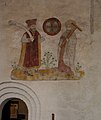
Sauvo is a municipality of Finland. It is located in the Southwest Finland region. The municipality had a population of 2,969 and covers an area of 299.47 square kilometres (115.63 sq mi) of which 47.21 km2 (18.23 sq mi) is water. The population density is 11.75 inhabitants per square kilometre (30.4/sq mi).

Karuna was a municipality in Southwest Finland region of Western Finland Province, Finland, until 1969 when it merged into the municipality of Sauvo. Part of the former municipality, the village of Sandö, was merged into the municipality of Kimito. In 1963, Karuna had 1,213 inhabitants. About 700 people inhabit the area currently. A peculiarity regarding the church of Karuna is that the older wooden church from 1685 was transported into the open-air museum of Seurasaari, Helsinki, and replaced by a stone church in 1910 designed by Josef Stenbäck.
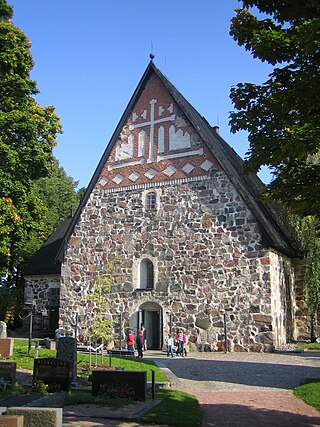
Espoo Cathedral is a medieval parish church and cathedral in Espoo, Finland. It is the seat of the Evangelical Lutheran Diocese of Espoo, established in 2004. The cathedral is located in the district of Espoon keskus, near the Espoonjoki river. The oldest parts of the church were completed in the 1480s and it is thus the oldest preserved building in the city.
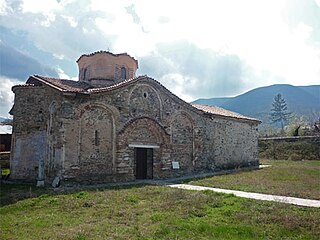
The Church of St Demetrius is a medieval Eastern Orthodox church in southwestern Bulgaria. It lies in the village of Patalenitsa, administratively part of Pazardzhik Municipality within Pazardzhik Province. The church was built in the 11th–14th century, with a possible dating to 1091 based on a stone plate inscription, the present location or even existence of which is unclear. Its frescoes, discovered in 1961 and restored in the 1970s, are a work of the 12th–13th century.
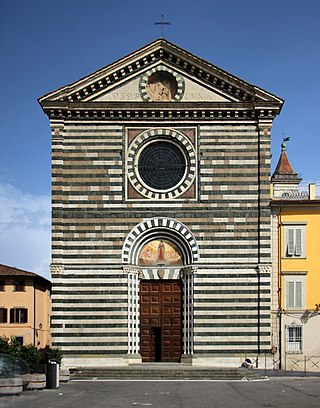
San Francesco is a Gothic-style, Roman Catholic church located in front of the square named after the church, in the historic center of Prato, region of Tuscany, Italy.

Karja Church is a medieval Lutheran church located in the Linnaka village on Saaremaa island, Estonia. It is the rural church with the richest medieval stone sculpture decoration in all the Baltic states.

Östra Hoby Church is a medieval Lutheran church built in the Romanesque style. Located 4 km east of Borrby in Skåne County in southern Sweden, it belongs to the Diocese of Lund. The church is noted for its murals and for its sculpted baptismal font.
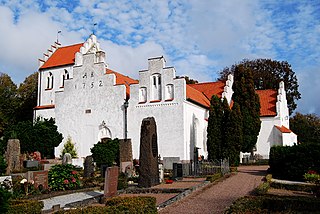
Brunnby Church is a medieval Lutheran church about 9 km (5.6 mi) north of Höganäs in southern Sweden. It belongs to the Diocese of Lund. The church is noted for its many 15th-century murals, attributed to the Helsingborg Workshop.
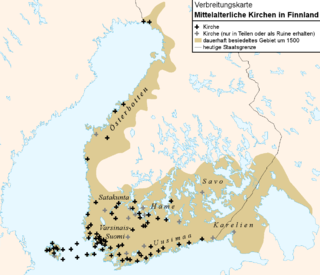
Medieval stone churches in Finland were built between the 13th and 16th century. The total number of churches was 104, of which 83 have been preserved. Numbers include the sacristies of uncompleted churches. Finnish medieval stone churches are mainly located in the western and southern parts of the country. They were usually fieldstone churches made of grey granite. Some are built of red granite and limestone while two churches are made of brick.

St. Mary's Church, Ystad is a medieval Lutheran church in Ystad, Sweden. It is the main church of the city.
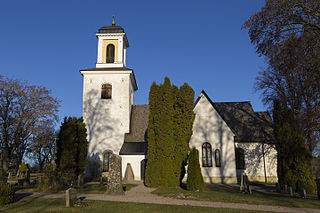
Alsike Church is a Lutheran church at Alsike in Uppsala County, Sweden. It lies in Knivsta Municipality, a suburb to Stockholm. The church is associated with the Archdiocese of Uppsala of the Church of Sweden.
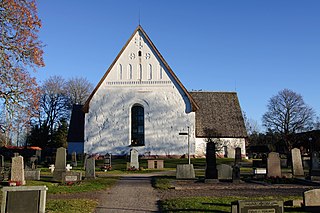
Valö Church is a Lutheran church in the Archdiocese of Uppsala in Uppsala County, Sweden. It has been described as one of the most interesting countryside churches in Uppland, with regard to its furnishings and frescos.

Kalix Church is a medieval Lutheran church in Kalix in Norrbotten County, Sweden. It belongs to the Diocese of Luleå. The church is the northernmost medieval church of Sweden.
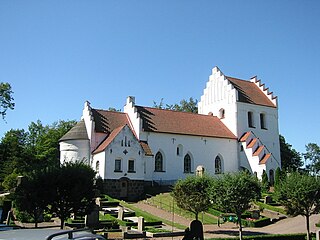
Sireköpinge Church is a medieval Lutheran church east of Landskrona in the province of Scania, Sweden. It belongs to the Diocese of Lund.

St Saeran's Church lies in the village of Llanynys, Denbighshire, Wales. It was listed by Cadw at Grade I on 19 July 1966. Between 2013 and 2015 £2.5 million was spent preserving the church, which has one of the finest medieval paintings in North Wales. The church's former importance is today evidenced in the sheer size of the interior which is large and spacious; it had close links with the Bishops of Bangor, who were its "rectors" or owners. Like many Denbighshire churches it is double-naved and has a fine pair of the characteristically local late-medieval hammerbeam roofs. The fluted timber pillars between the naves are more unusual, and much later, dating from a restoration in 1768.

Vallstena Church is a medieval church on the island of Gotland, Sweden. It belongs to the Diocese of Visby.

Viksta Church is a medieval church located north of Uppsala in Uppsala County, Sweden. It is part of the Archdiocese of Uppsala.

Knislinge Church is a medieval church in Knislinge, Östra Göinge Municipality, in the province of Skåne, Sweden. The church contains several medieval murals as well as a sculpted, Romanesque baptismal font.
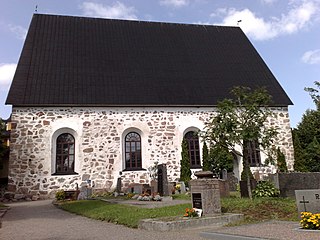
Siuntio St. Peter's Church is a gothic medieval stone church in Siuntio, Uusimaa, Finland, located in the old church village of Siuntio. The church is built out of grey stone between the years 1460 and 1480 next to a small stone chapel which was owned by a nearby Suitia Manor. St. Peter's Church is divided into three naves by three pairs of pilars that hold the brick vaults.

Saint Nicholas Church of Ingå is a medieval church in Ingå, Finland. The church is owned by the evangelical-lutheran parish of Ingå.




